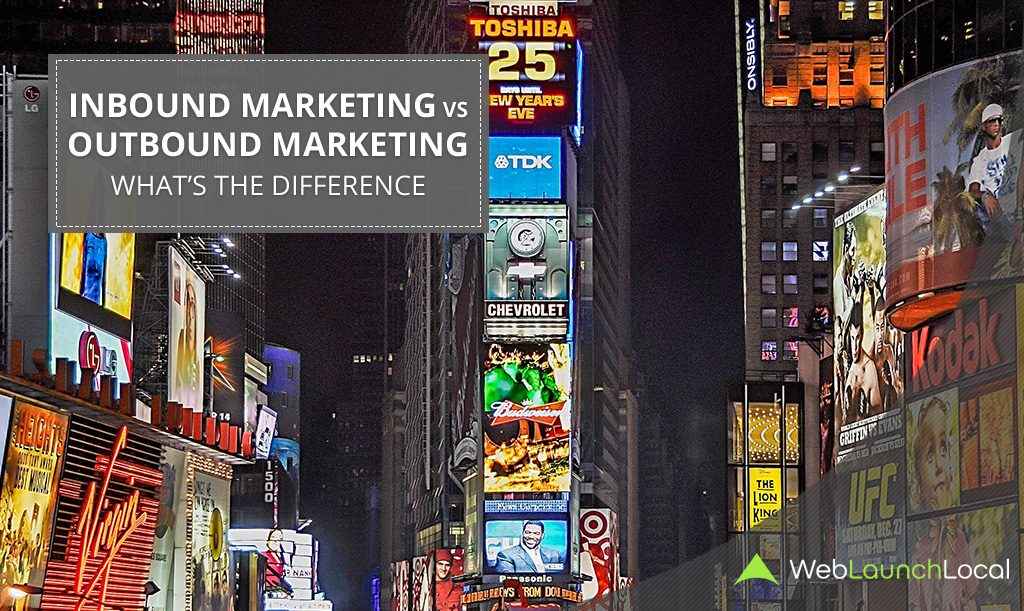
One of the two most common terms you can bump into in the world of marketing is inbound and outbound marketing.
What’s the big difference between inbound marketing and outbound marketing? They’re both used to bring in customers, right? Well, yes, but that’s where the resemblance ends. Let’s jump in and find out what type of marketing is the best choice for you.
What is Inbound Marketing?
Inbound Marketing is a new marketing tactic that was coined by HubSpot’s CEO in 2006 to create marketing that makes a personal relationship with consumers. It’s creating relatable content that inspires people to identify themselves and ask for more information or make a purchase.
A relatable content gives incentives that can attract customers or clients to buy your products or services. It is closely aligned with content marketing, social marketing, and Search Engine Optimization (SEO)—these programs focuses on attracting unknown consumers to your business.
According to HubSpot, “Inbound marketing focuses on creating quality content that pulls people toward your company and product, where they naturally want to be. By aligning the content you publish with your customer’s interests, you naturally attract inbound traffic that you can then convert, close, and delight over time.” Inbound marketing is permission-based marketing. When done correctly, inbound marketing is exponentially more successful than outbound marketing.
Above is an illustration of HubSpot’s The Inbound Methodology.
Inbound marketing concentrates on attracting customers through relevant and helpful content and adding value at every stage in your customer’s buying journey. Unlike outbound marketing, inbound marketing does not need to fight for potential customers attention.
Inbound marketing is the pull strategy while outbound marketing is a push tactic. It relies on creating valuable content and attracting visitors with it. It depends on the development of the Internet, mobile phones, and social media platform to draw consumers in. Instead of urging a message out onto a large population, inbound marketing attracts specific audiences that are out there looking for information.
With the help of inbound marketing, potential consumers find you through channels like blogs, search engines, and social media. By creating content intended to address the needs and problems of your target market, you can attract qualified prospects and that way; you can build trust and credibility for your business.
Its goal is to pull people toward the marketing materials and attract them to the business with relevant information. This technique is done by arranging a wide variety of online marketing assets that are ready and waiting for interested consumers to find.
These selling points are blog posts, a dynamic social media presence, websites and paid advertising optimized for specific Internet searches, and mobile apps. When people are drawn to your marketing content, they readily give their permission to receive more promotional material and information from you.
Next, what is Outbound Marketing all about?
Outbound Marketing is the conventional or “traditional” advertising methods which they were using in the past.
The primary idea is that advertisers use mass media tools such as televisions and radios advertising, print advertising, direct mail, outdoor advertising, and telemarketing. These mass media tools promote their products and messages out to the public. The goal is that if enough people who are in your target audience hear the news, they will respond.
Outbound marketing also suggested to as interruption marketing, involves getting your marketing message to the most significant number of people possible through cold calling, advertising, direct mail and other aggressive techniques that interrupt people in their daily lives.
Outbound Marketing is intrusive and keeps on pushing their message without the audience’s permission. Outbound Marketing is interruptive. It promotes its tactics even if you are not a part of its target market. Its one-way communication and marketers provide little to no value. Outbound Marketing sought-after customers.
These marketing strategies were useful, but nowadays these ads are so saturated and so alike that people no longer pay attention to them.
Unlike inbound marketing, these mediums are less effective because many people who are not in your target consumers are also exposed to your message.
When you use outbound marketing, it is like a one-way relationship. You target audience always hear from you, but you don’t. It lacks the personal relationship that inbound marketing has. Outbound means that you often require the data needed to adjust your tactics and your budget.
This traditional marketing is interruptive. Commercials interrupt television shows. This “push promotion” worked in the mass media age, but the present communications technology has allowed people to avoid and escape these annoying interruptions.
Which is more important: Inbound Marketing and Outbound Marketing?
There are definite advantages to both inbound and outbound marketing for lead generation. In specific situations, you’ll see more benefits from the other type than the other. While inbound marketing leads tend to be more cost-efficient and can become a better strategy for a long-term, but outbound tactics are best reserved for when you need to generate leads quickly.
Both inbound and outbound are vital to your business’ success. Inbound is necessary to replenish your sales pipeline generating new leads, while outbound helps you drive and track your existing consumers through the buying cycle. Only through the combination of both marketing techniques can you build a useful lead generation engine capable of filling your sales pipeline.
Choosing the right marketing technique for your business is tough, but once you’ve chosen the best for you, it will lead to greater leads and sales. Don’t be scared to ask for help. You can seek assistance from a professional digital marketing agency with your digital marketing needs.
Tags: difference between inbound marketing and outbound marketing


